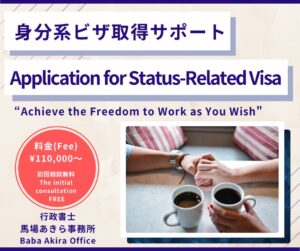日本人の配偶者等 Part 2: Application Process and Required Documents for Obtaining the Residency Status
Obtaining the “Spouse or Child of Japanese National” residency status requires accurate procedures and thorough documentation. This article explains the overall application process and the key documents needed.
1. Overview of the Application Process
The process to obtain the “Spouse or Child of Japanese National” residency status involves the following steps:
- Prepare the necessary documents
- Submit the application to the Immigration Services Agency
- Review and notification of the result
- Receive the residence card
2. List of Required Documents
The main documents required for submission include:
A. Basic Documents
- Application form for the Certificate of Eligibility (specific format)
- Photo (4 cm × 3 cm): Taken within the last three months
- Copy of the applicant’s passport (for identity verification)
B. Documents to Prove the Marital Relationship
- Certificate of Acceptance of Marriage Notification or Family Register (Koseki Tohon) (for the Japanese spouse)
- Marriage certificate (if married abroad)
- Photos and communication records (to demonstrate the authenticity of the relationship)
C. Documents Demonstrating Financial Stability
- Taxation certificate of the Japanese spouse
- Income certificate: Most recent
- Certificate of employment
D. Other Required Documents
- Questionnaire: Details about the couple’s relationship history and daily life
- Statement of reason (if applicable)
3. Key Points for Submission
A. Accuracy and Consistency of Documents
- Submit up-to-date documents:
Old documents or inconsistent information can cause delays or lead to denial. - Translation requirements:
Documents in foreign languages must be accompanied by a Japanese translation.
B. Importance of Proving the Marital Relationship
- Provide evidence of a genuine marriage:
Photos, communication records, and wedding documentation can strengthen credibility. - Avoid false applications:
Misrepresentation can result in future application difficulties or deportation risks.
4. Application Process Flow
- Gather the documents and submit them to the nearest Immigration Services Agency:
- Booking an appointment in advance can streamline the process.
- Application review begins after submission:
- The typical review period is 1–3 months.
- Notification of results:
- If approved: A Certificate of Eligibility is issued.
- If denied: Review the reasons and prepare for a reapplication.
5. Important Considerations During the Review Period
- Be prepared for additional document requests:
Additional documents may be requested during the review. Respond promptly.
Next Topic Preview
In the next article, we will discuss “Key Tips for Successful Applications and Common Mistakes.” Learn how to improve your chances of success and avoid common pitfalls.
The path to obtaining residency status requires careful preparation. With the right steps, you can navigate the process smoothly and confidently!
